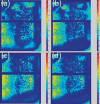An Anthropomorphic Head and Neck Quality Assurance Phantom for Credentialing of Intensity-Modulated Proton Therapy
- PMID: 31773010
- PMCID: PMC6871565
- DOI: 10.14338/IJPT-17-00005.1
An Anthropomorphic Head and Neck Quality Assurance Phantom for Credentialing of Intensity-Modulated Proton Therapy
Abstract
Purpose: To design and commission a head and neck (H&N) anthropomorphic phantom that the Imaging and Radiation Oncology Core Houston (IROC-H) can use to verify the quality of intensity-modulated proton therapy H&N treatments for institutions participating in National Cancer Institute-sponsored clinical trials.
Materials and methods: The phantom design was based on a generalized oropharyngeal tumor, including critical H&N structures (parotid glands and spinal cord). Radiochromic film and thermoluminescent dosimeter (TLD)-100 capsules were embedded in the phantom and used to evaluate dose delivery. A spot-scanning treatment plan with typical clinical constraints for H&N cancer was created by using the Eclipse analytic algorithm. The treatment plan was approved by a radiation oncologist and the phantom was irradiated 4 times. The measured dose distribution using a ±7%/4 mm gamma analysis (85% of pixels passing) and point doses were compared with the treatment planning system calculations. The prescribed target dose was 6 Gy (RBE) with 646.2 cGy (RBE) and 648.6 cGy (RBE) planned to the superior and inferior TLD, respectively.
Results: For point dosimetry, the average measured-to-calculated dose ratios were 0.984 and 0.986 for the superior and inferior target TLD, respectively. Dose values for the superior and inferior target TLDs were 636.1 cGy and 639.6 cGy, respectively. For the relative dose comparison, the pixel passing rates for the axial and sagittal films, respectively, were 95.5% and 94.2% for trial 1, 97.3% and 93.2% for trial 2, 93.4% and 90.0% for trial 3, and 96.2% and 92.7% for trial 4.
Conclusion: The anthropomorphic H&N phantom was successfully designed so that TLD measured-to-calculated ratios were within IROC-H's 7% acceptance criteria, 1.6% and 1.4% lower than expected for the superior and inferior target TLDs, respectively. All trials passed the 85% pixel passing criteria established at IROC-H for the relative dose comparison performed when using a gamma index of ±7%/4 mm.
Keywords: Imaging and Radiation Oncology Core; National Cancer Institute; anthropomorphic head & neck phantom; proton therapy; quality assurance.
© Copyright 2017 International Journal of Particle Therapy 2018.
Conflict of interest statement
Conflicts of interest: The authors have no conflicts to disclose.
Figures



References
-
- The National Association for Proton Therapy. The National Association for Proton Therapy's Home Page. 2017 http://www.proton-therapy.org/ Accessed April 1, 2016.
-
- MD Anderson Imaging and Radiation Oncology Core. IROC's Home Page. 2017 http://rpc.mdanderson.org/RPC/home.htm Accessed April 1, 2016.
-
- Guidelines for the Use of Proton Radiation Therapy in NCI-Sponsored Cooperative Group Clinical Trials. (n.d.) Retrieved April 1, 2016, from http://rpc.mdanderson.org/RPC/home_page/Proton_guidelines.htm.
LinkOut - more resources
Full Text Sources
